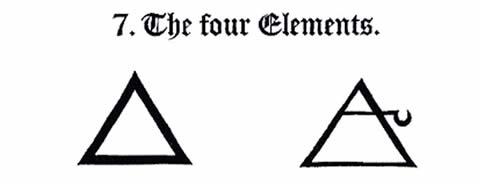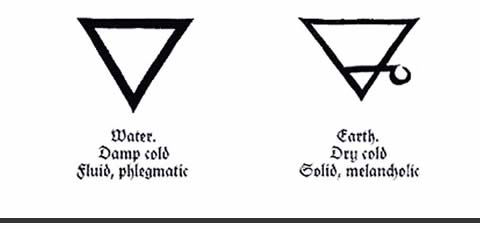 ISIDORUS,
De Responsione Mundi... Augsberg 1472 ISIDORUS,
De Responsione Mundi... Augsberg 1472
 Van
de Velde, 2 engraving from his series, The Four Elements Van
de Velde, 2 engraving from his series, The Four Elements
"In this order, hot things are in harmony with cold, dry with moist,
heavy with light, great with little, high with low. In this order, angel
is set over angel, rank upon rank in the kingdom of heaven; man is set
over man, beast over beast, bird over bird and fish over fish, on the
earth, in the air and in the sea: so that there is no worm that crawls
upon the ground, no bird that flies on high, no fish that swims in the
depths, which the chain of this order does not bind in the most harmonious
concord. Hell alone, inhabited by none but sinners, asserts its claim
to escape the embraces of this order...." Sir John Fortescue,
trans. On Nature , 1492.
The Elements are unified by love, and disintegrate through disunity. They
are mixed in two regions, the Universe (Constancy)and the Sublunary (mutability).
Above the moon elements mix perfectly, beneath the moon imperfectly. In
Ramon Lull's Tractatus novus de astronomia ABCD in the
alphabet somehow represent the Four Elements, which if understood, represented
the basic patterns of nature by which everything could be understood.
Illustration above from Rudolph Koch's The Book of Signs ,
originally published by the Limited Editions Club, London 1930, with introduction
by A.J.A Symons, and reprinted by Dover Books New York, in 1955.
1. FIRE ; hot + dry- choleric - tetrahedron- sharp tenuous and mobile
- Ignis
2. AIR ; hot + moist - sanguine - octahedron - sharp, mobile and weighty
- Aer
3. WATER; moist + cold - phlegmatic - icosahedron - mobile, blunt and
weighty - Aqua .
4. EARTH ; cold + dry- melancholic - cube blunt, weighty, immobile - Terra
Hence, the sign for Water + the sign for Fire = alcohol (the hexagram
for fire water).
There was
some support for a fifth Element some said it was Quinta Essentia, (the
quintessential) some said it was Ether.
"Earth being the Subsidence or remains of that
Primitive Masse, which God formed out of Darkness, must needs be a faeculent
impure body, for the extractions that the Divine Spirit made, were pure
oleus, aethereal substances, but the crude phlegmatic indigested humours
settled like Lees to the Centre.
Water This is the First element we read of in Scripture;
the most ancient principles and the Mother of all things among visibles.
Without the mediation of this, the Earth can receive no blessing at
all. The common Element Water is not altogether contemptible but there
are hidden treasures in it.
Air ; this is no element, but a certain miraculous
Hermaphrodite, the Caement of two worlds and the medley of Exteremes.
In this are innumerable magic forms of Men and Beasts, Fish and Fowle,
Trees Herbs and all creeping things.
This Fire passeth through all things in the world and
it is Nature's Chariot, in this she rides : when she moves, this moves,
and when she stands this stands, like the wheels in Ezekiel whose motion
dependeth on that of the spirit. This is the mask and screen of the
Almighty." Thomas Vaughn.
Early maguses who interested themselves in theories of transmutation include
John Dee and Robert Fludd. Robert Fludd, Tomus Secundus De Supernaturali,
de Bry, Oppenheim 1619,The Macrocosm, The creation of the Universe and
the metaphysical principles that govern it ; the appearence of light,
the division of the waters; the three realms, angelic, celestial, elemental;
FILM COMPILATION
(40 mins)
1. Walter Hill (directs) Streets of Fire , Universal
US 1984; a celebrated exercise in dark savage editing of images to rock
music. A Rock and Roll Fable set in No Time. Cutting red into blue, contrasts
of rhythmic action and stasis. "it is also violent , though its violence
lies not in the depiction of blood and entrails but in the sheer energy
and speed with which the dark and brooding images rush after one another.
The beginning of the show.
2. Elem Klimov, Come and See (Idi I Smotri), USSR 1985,
two partisans seek their families in the silage stained bogland of Soviet
Byelorussia during the Second World War. Under the impression that their
families are concealed on an island they drag themselves through poisonous
slime to find them not there, and by implication, killed by the invading
Nazi soldiers. The unnerving strains of a muffled waltz underscores the
agony and muscular strain.
3. The Gluttonous in Hell sequence from Peter Greenaway's A TV
Dante, made in collaboration with the painter Tom Phillips, UK
1988, bodies oozing in the slime of their own vices, the winning combination
of food and sex, compartmentalised by computer for the small screen. In
Dante's Hell, the Elements each have their part to play.
4. Spaceship Earth , a documentary on the implications
of aerial photography, the planet viewed from above, that 80% of the earth
desertification is caused by human beings own efforts. The Iran USSR border,
the outbreak of overgrazed land.
5. Werner Herzog, Lessons of Darkness, Germany 1991,
a section of Herzog's impressive evocation of the Gulf War, from the city
of Kuwait before the War to the destruction and subsequent capping of
the oil wells. Dynamite is held to the ignited source of oil and the fire
put out. Oil rains down upon the desert.
6.Akira Kurosawa, The Throne of Blood (Kumonosu-jo),
Japan 1957, and the director's filming of Shakespeare's Macbeth.In this
section, the samurai Washizu and his companion are lost in Cobweb Forest
after their defeat of the Lord of the Castle's enemies. All the elements
combine in a terrifying storm which also causes the materialisation of
demons in the forest. A witch appears and prophesies the fate of the two
warriors. The magical presence disappears.
7. Peter Greenaway, Prospero's Books, Netherlands France
Italy, 1991, Greenway's filming of Shakespeare's The Tempest , a visual
fusion of the four elements on the magic island where a butler Stephano
and a jester Trinculo shipwrecked on Prospero's magic isle, encounter
Caliban the beast of the basic element of earth who tries to enlist them
in his attempts to kill his master Prospero. "Greenaway interprets
The Tempest as a mind (Prospero's) reviewing its entire contents..."
( Sight and Sound Sept 1991 issue 5.)
8. Charles and Ray Eames, Power of Ten, a superb graphic
evocation of the macrocosm and the microcosm; space beyond and space within,
a familiar medieval conceit, here explained to a lay audience in the most
rational and lucid way, funded by IBM. The Eames Office , a lifelong partnership
of Ray and Charles, was also known for furniture, corporate design and
editorial design. See Capalana and Morrison, Connections, The Work of
Charles and Ray Eames , exhib.catal., Los Angeles, 1976.
|
BOOKLIST
Frances Yates, The Art of Memory , Penguin, Harmondsworth
1966, see Chapter 6, "The Memory Theatre of Giulio Camillo".
Arnold Whittick, Symbols, Signs and their Meaning , Hill
London 1960
Richard Foster, Patterns of Thought, The Hidden Meaning of the
Great Pavement of Westminster Abbey , Cape London 1991
Mark Haeffner, The Dictionary of Alchemy , Haper/Collins
London 1991
Herbert Silberer, Hidden Symbolism of Alchemy and the Occult Arts,
Dover New York 1971 (1917)
Nigel Pennick, Sacred Geometry, Symbolism and Purpose in Religious
Structures, Turnstone Press,W'borough, 1980
Charles Nicholl, The Chemical Theatre , Routledge, Kegan
Paul, London 1980 see Chap.5, "Alchemical Patterns in John Donne".
Douglas Brooks-Davies, The Mercurian Monarch , Magical politics
from Spenser to Pope, Manchester Univ.Press, Manchester 1983
Dan Pedoe, Geometry and the Liberal Arts , Penguin Harmondsworth
1966
Frances Yates, Theatre of the World , Routledge London
1987
Frances Yates, The Rosicrucian Enlightenment , Ark, London
1986
William Shakespeare, The Tempest, intro. Frank Kermode,
Arden edition, Methuen London 1968
D.J.Palmer, Shakespeare The Tempest , A Selection of Critical
Essays, Macmillan London 1968
Peter Greenaway director, Prospero's Books , film 1991.
Frances Yates Collected Essays, Volume 1, Routledge,
London 1982, see "The Art of Ramon Lull". |



















